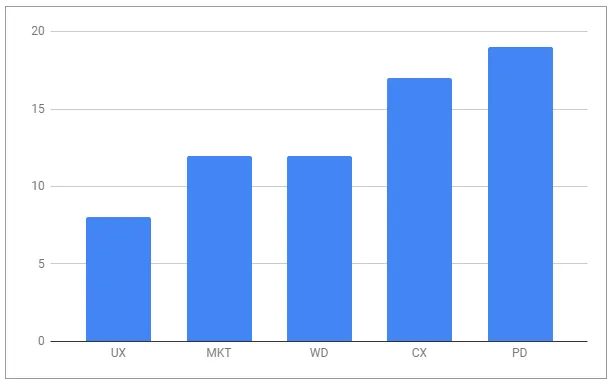
Tools for UX?
It's a bit of a confusing area.

I had an experience looking for the “perfect UX tool”, but where I ended up showed something I didn’t expect.
There is a gray area that I charitably call “unknown” in the midst of these tools and honestly it is not very easy to say what it is.
The challenge
Over the last few months I have been looking for a tool that would meet the needs of the company where I work (we make software for public management). We have many products (more than 20) and a range of users so large that we can call it a society. And when I say this, I mean it in no other sense, we really serve the population of all the cities that are our customers.
What is this need?
Basically it is: understanding who the users are for each client, for each product, without having to go through an extensive UX process. And, if possible, do this automatically with constant updates. This way, we make decisions in real time, modifying each product appropriately.
Large companies generally do not have a range of products as extensive and complex as what we have here.
What we generally see are: large companies, with high revenues, with one or two products. Sometimes even one or another product that helps the main thing, but doesn’t reach the public. I also searched for companies that have a wide range of products like ours, but I didn’t find anyone that had a UX team, or tracked user information is with its own tool.
I decided to look for it on my own and the work was great I started researching the tools, and in fact, I entered an unknown place. The range of tools that a UX Designer can serve is wide. I felt like I was in a department store, tempted to buy 50 different types of the same product.
I made a spreadsheet to compare the tools and the features they have (or not) in common. I listed the features that would be essential for our company by testing some tools in the profile I had established, which is basically a tool with:
- Heatmap (Records user clicks and scrolls)
- Session Recording (Records user interaction)
- Funnel analysis (Identifies the screen navigation flow)
- Form analysis (Identifies how used the fields are)
- Search (Search box to be answered only once)
- Feedback (Button to give feedback whenever the user wants)
- A/B/n Testing (Test variations in process flow)
- Dash with UX Metrics (NPS, CSAT, CES, SUS, etc.)
I came up with a list of 12 tools:
HotJar, Mopinion, Mouse Flow, Freshmarketer, Feedbackify, Crazy Egg, User Snap, Session Cam, Track Duck, Click Tale and Smart Look.
Each of these tools was very complete, but something was always missing. Using two tools to complement each other would be one of the solutions, however, the prices of each one (even in dollars) and the cost-benefit were not very attractive.
I tested them all and concluded: Freshmarketer was the winner. Chosen as the best tool for each feature. We even used it with a product in production, when we were about to close the purchase, I decided to research it further.
The unknown
I changed the search category to: “feedback tools” and discovered 13 new tools. I researched a little more, changed the category again to: “user testing tools”, and found 9 more.
Today, the spreadsheet has 34 different tools and 25 features that can be compared. A lot of things!
You might be thinking: “ok, okay, you found a lot of tools of different types that can help you, but what’s the problem with that?”
The problem is that each of them is apparently for a different target audience. It seems like each company pitched itself to a different niche. The tools I found are for:
- Web Designer → Track your website information
- CX → Research customer satisfaction
- Product Designer → Test an MVP before launching
- Marketing → Reach more customers/sales/users
- UX → Understand User behavior, their difficulties, where to improve unique experiences.
They all have practically the same purpose:
Know who your user is, how they behave, and what they think about your product.
And where is the UX in this story?
Relationship of number of tools x target audience
 In the graph above, we see that UX, despite being present, is not yet a focused area of these tools. Most attend to UX in conjunction with other areas. Only one tool was specifically in the UX area.
In the graph above, we see that UX, despite being present, is not yet a focused area of these tools. Most attend to UX in conjunction with other areas. Only one tool was specifically in the UX area.
Don’t get me wrong, all of these tools can be used to add value to your work/product and bring returns in various ways. What I want to show is: the UX tools market is new, little explored, but full of opportunities!
I realized throughout this analysis that it is difficult to have just one tool that meets all these needs.
What did I decide to use?
Google Marketing Platform. It’s not a specific tool in the UX area (obviously, the name has marketing), but it was the group of tools that served us best, and at a very low cost. The Google Marketing Platform is made up of:
- Google Analytics — Tracks product information, such as pages, number of visits, number of users, most visited pages, location, age, gender, interests and much more;
- Google Optimize — Multivariate testing, A/B/n, redirection testing and content personalization tools;
- Google Surveys — Open and closed public survey tool (can be sent to anyone, or to users of your product);
- Google Data Studio — Tool for creating dynamic dashboards (like PowerBI);
- Google Tag Manager — Tag management tool (Basically controls which product receives which tool) And the best part? All free.
What can you take away from this?
So, to conclude: The perfect UX tool does not exist! In the end, nothing beats a good conversation with your user. For now we won’t have a tool with all the cool features, but nothing stops us from creating the next generation of UX tools.